MYCO | 1.4 Fungal Growth, Differentiation, & Development
1/124
There's no tags or description
Looks like no tags are added yet.
Name | Mastery | Learn | Test | Matching | Spaced |
|---|
No study sessions yet.
125 Terms
3 driving forces of hyphal apex growth
tca
Turgor pressure (fluid from protoplasm pushing against CW)
CW formation itself (delivery of vesicles by cytoskeleton, TVS)
Actin
_ in Phytophthora infestans (water mold, Oomycete) controls hyphal tip sharpness during penetration and is triggered by mechanical stimulation
Actin-based mechanostat
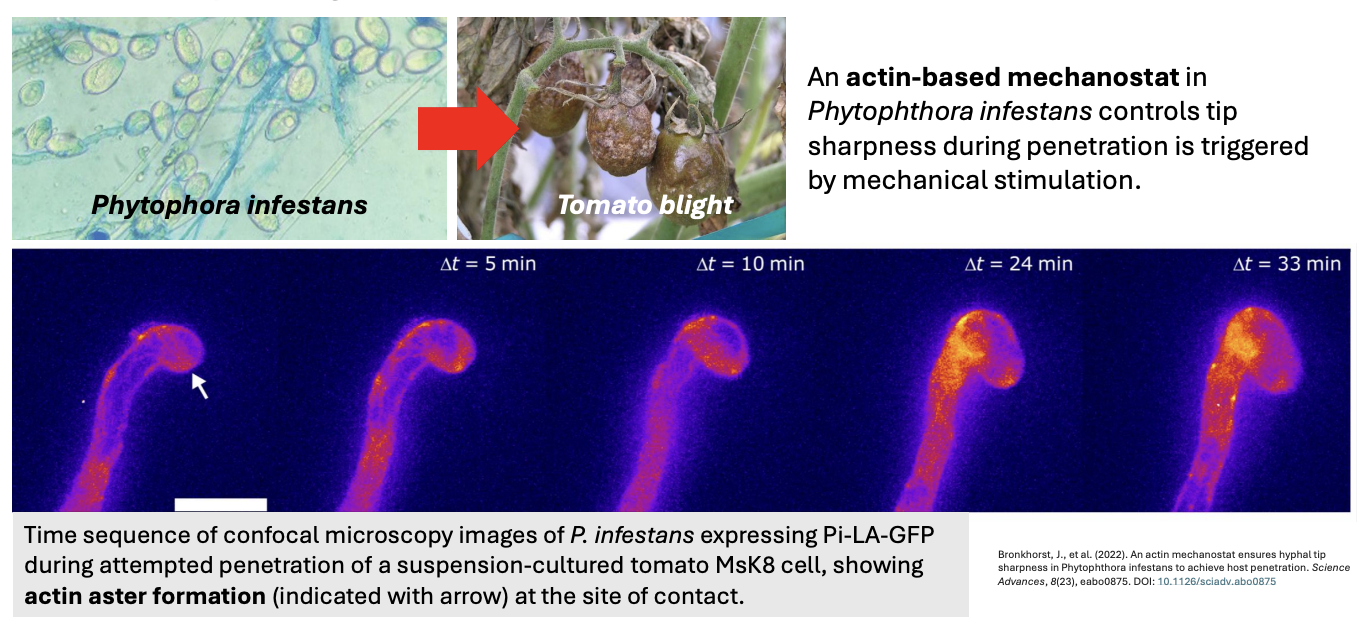

Explain the figure
Point is to show that among driving forces of hyphal apex growth is also actin-based mechanostat
Figure demonstrates time sequence microscopy images of P. infestans (expressing GFP) during its attempted penetration of suspension-cultured tomato MsK8 cell, showing actin aster formation at sites of contact (suggests mechanical stimulation of hyphal tip growth)

The actin-based mechanostat in P. infestans enhances its ability to penetrate host surfaces by _
modulating hyphal tip sharpness in response to mechanical cues
Apart from hyphal growth, fungal spores are also used for _
dispersal or dormant survival
There is an extreme diversity in terms of fungal spores, but the common definition is that these are: _
microscopic propagules that lack an embryo and
specialized for dispersal or dormant survival
Germination in spores only occurs when suitable growth parameters are encountered, including factors such as _
mnt
Moisture
Nutrients
Temperature, etc.

Explain figure
Aspergillus sp. grown at different temp conditions
At consistent 30 C, spore germinates into germ tubes, develops into a hypha, eventually forming a filamentous fungi
Shifting from 44C to 30 C (temperature shock), spore directly forms a spore-bearing structures (to ensure survivability while reducing energy costs)
Some spores have an obligate site of germination called _, where CW is usually the thinnest
Some, however, undergo _, where germination can start from any point of the spore that grew isotropically
Germ pore (e.g., Paneolus sp.)
Non-polar growth
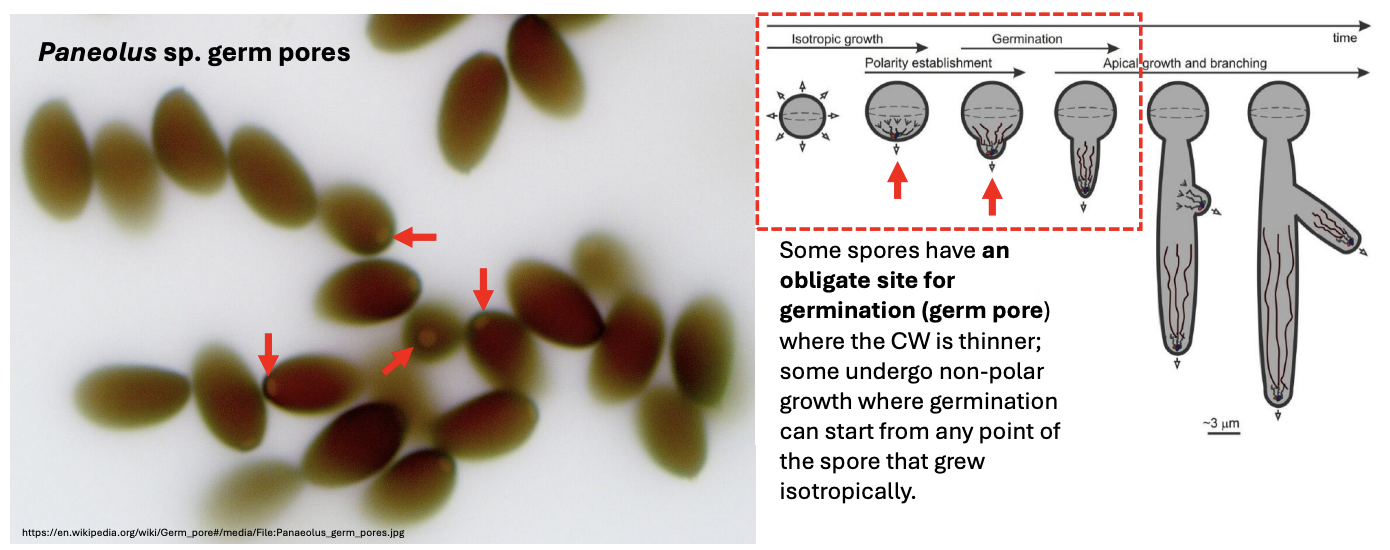

How is polarity established during spore germination?
Through the accumulation of vesicles because the spores themselves will not have SPK yet until proper conditions for germination are met

T/F: A fungus can re-establish a new polarity position that will allow it to penetrate a particular structure despite germ tube being oriented in different direction
TRUE
_ aid in orienting the direction of hyphal growth
Spore tropisms
Directional growth response of an organism to an external stimulus
Tropism
T/F: Polarity is established in spores through spitzenkorper
FALSE
Spores will not establish spitzenkorper until the proper condition for germination is countered. Rather, it is through accumulation of vesicles that polarity is established in spores.

Describe figure shown (2 examples of fungal species exhibiting spore tropism)
(A,B) Idriella bolleyi, which germinates towards dead root hairs that they penetrate and do not ever infect living ones
Have some kind of mechanism that can detect exudates from dead matters
(C,D) Geotrichum candidum exhibits negative autotropism (“grow against itself”; grow anywhere without spore)
T/F: Many fungal spores exhibit tropisms to various external cues
TRUE

Some spores exhibit _ towards cathodes (+) and anodes (-), as in the case of Pythium aphanidermatum and Phytophthora palmivora
electrotropism (cathodes in top part of root, canodes in bottom part)

Other spores show germination controlled by _, as in the case of C. albicans growing on the surface of scratched membranes and through surfaces of a nanopore filter after emerging from a pore
thigmotropism (touch/surface stimulus)
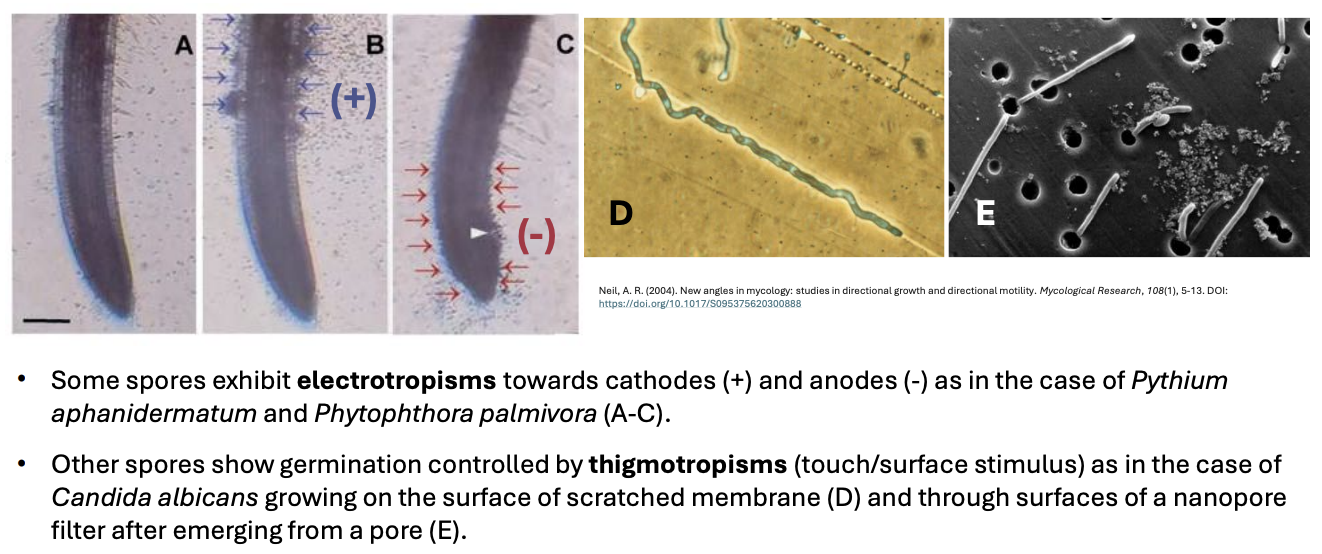
_ encompasses the spectrum of events required for the growth and division of individual cells within a muticellular fungal hyphae
Hyphal duplication cycle

Actin-based mechanostat in P. infestans controls _ during penetration and is triggered by _
Hyphal tip sharpness
Mechanical stimulation (evidenced by actin aster formation at contact sites)
(Hyphal) duplication cycle is different from the traditional cell cycle because _ and thus consists of 2 stages, namely _
Hyphal cells remain merged
Pre-divisional stage: elongation
Post-divisional stage: septum formation
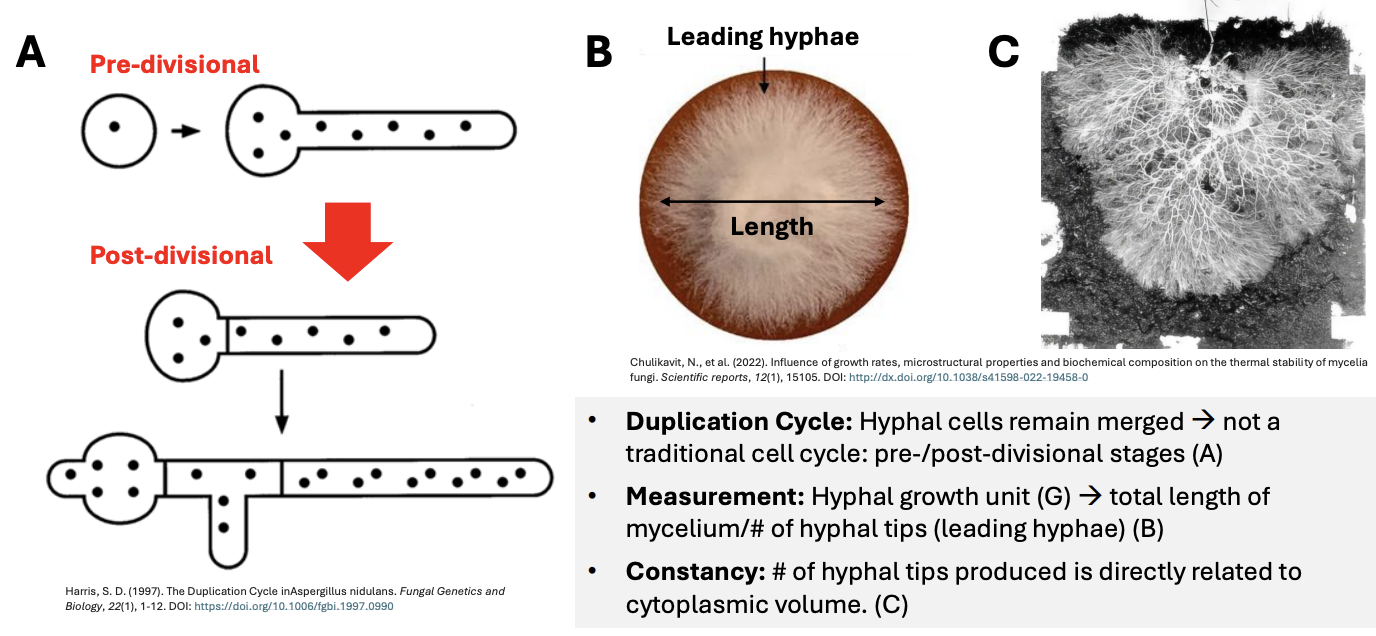
How is the hyphal growth unit (G) (during duplication cycle) measured?
Total length of mycelium (diameter) / number of hyphal tips (leading hyphae)
Modern: Measure mycelial diameter per day
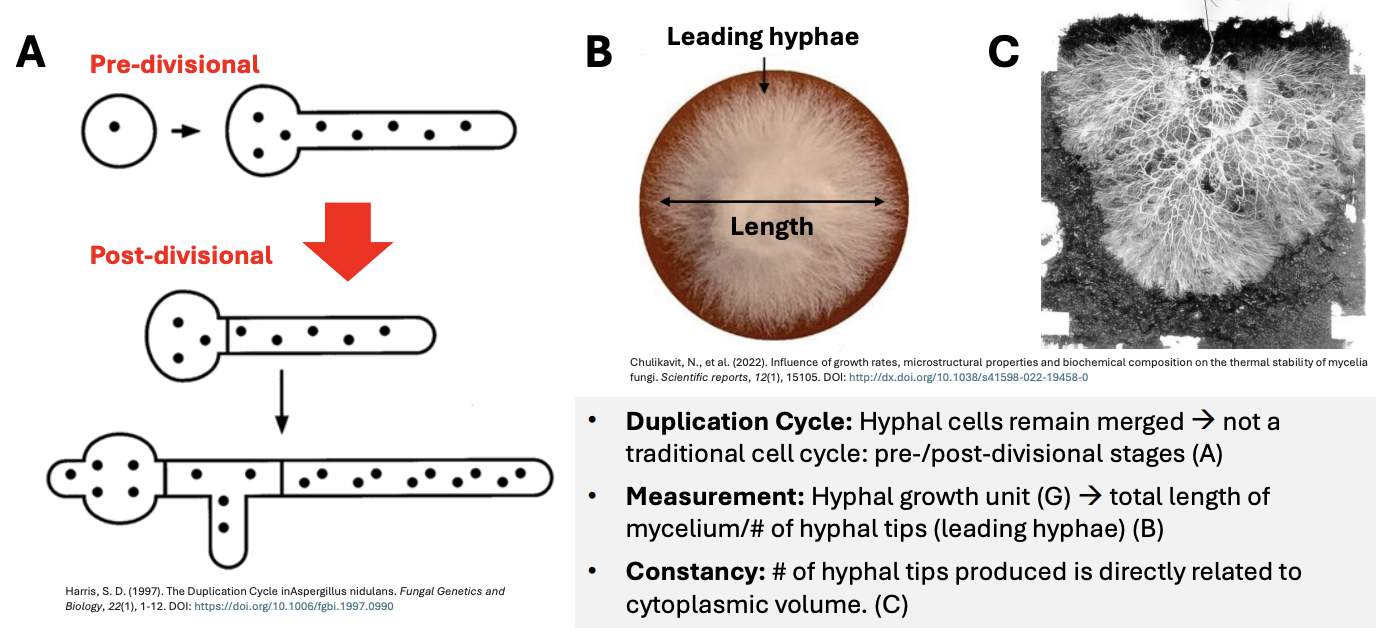
Explain constancy observed in hyphal duplication cycle
Number of hyphal tips produced is directly related to the cytoplasmic volume
Conidiation vs. Microcycle sporulation
Conidiation = production of asexual spores / conidia
Microcycle sporulation = production of spores without extensive hyphal development
_ is the production of spores from germinating spores, i.e., without extensive hyphal development
Microcycle sporulation
When subjected to stress conditions, many fungi do not produce mycelium but instead produce many spores through _
microcycle sporulation

_ is the model of the regulation of cell growth and division
Yeast cell cycle
Fastest yeast cell cycle takes _ hrs in S. cerevisiae, with wide limits depending on nutrient availability
~1.5 hrs
In yeast cell cycle, most variation in terms of duration occurs in _, while _
G1 phase (preparation for DNA replication)
S, G2, M together occupy more/less constant time
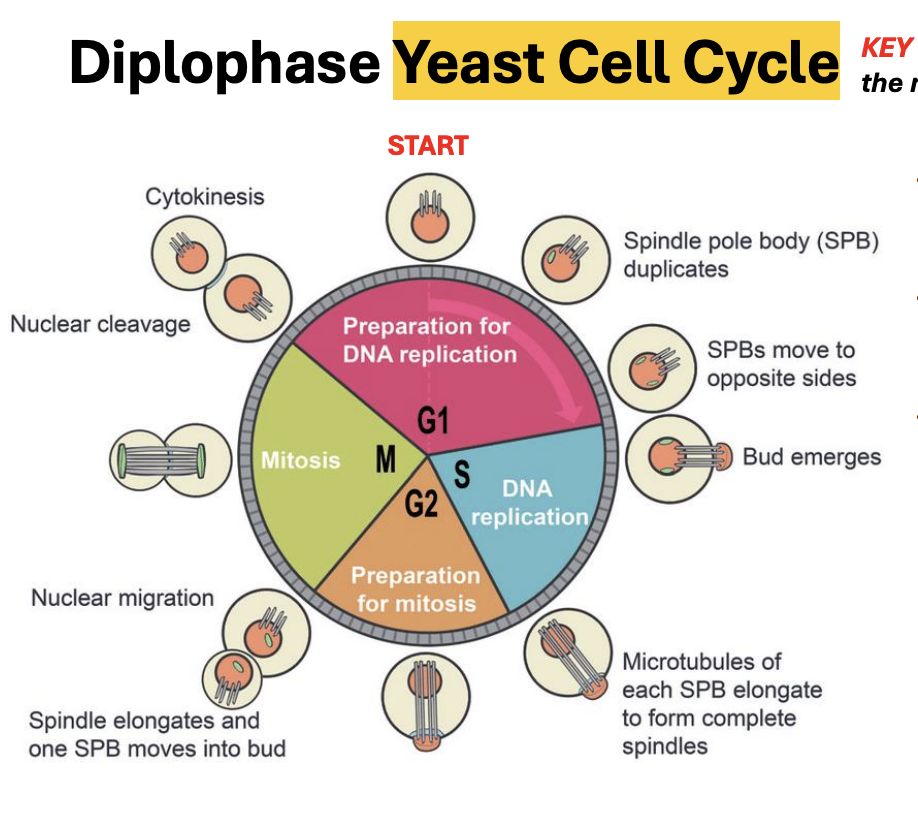

T/F: Some spores have obligate sites of germination called germ pores, where CW is thickest
FALSE
Some spores have obligate sites of germination called germ pores, where CW is thinnest
Most important checkpoint is called _ in S. cerevisiae because this is where the cell integrates all information from intracellular and environmental signals to determine whether: _
“Start” in G1 phase
Cell cycle will continue; cell will enter stationary phase; or cell undergoes sexual reproduction/enters haplophase


Microcycle sporulation serves as a mechanism to (1) _ and (2) _
Save nutrients and
Create a means of dispersal into more nutrient-rich environments
T/F: Fungi passing through microcycle sporulation have different morphological structures and properties
TRUE

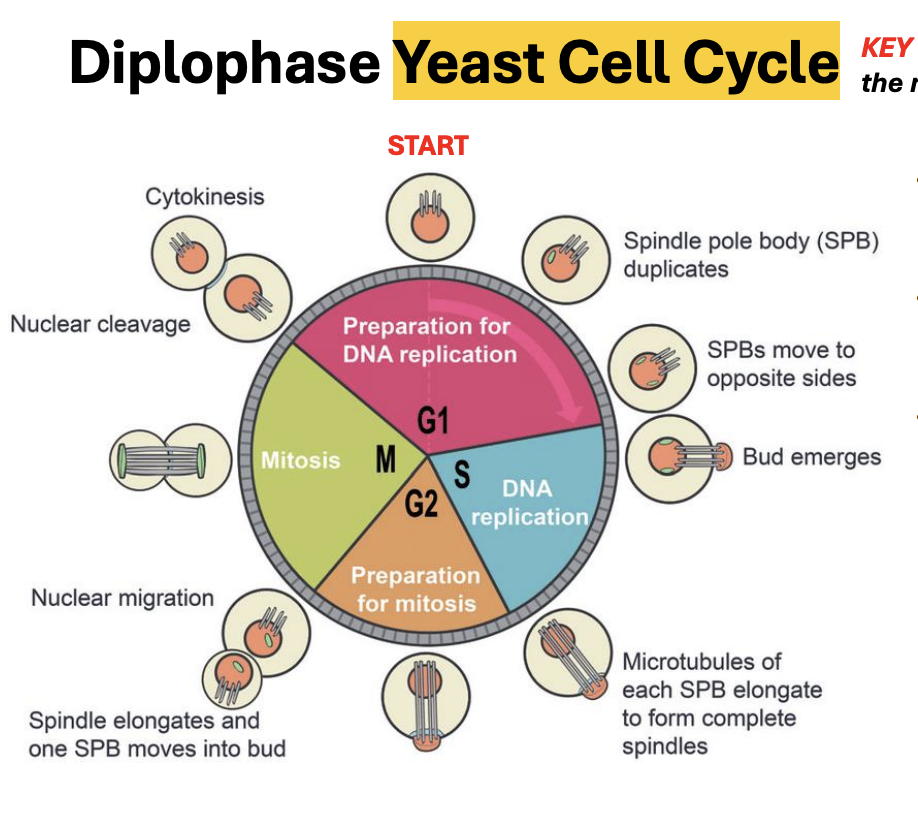
Explain diplophase yeast cell cycle
G1 (Prep for DNA replication)
Most important “Start” checkpoint, where it’s determined whether cell cycle continues, undergoes stationary, or haplophase (sex rep)
Spindle pole body (SPB) duplicates and moves to opposite sides at the end of G1
S (DNA replication)
Bud emerges
Microtubules of each SPB elongate to create complete spindles
G2 (Prep for mitosis)
M (nuclear division)
Spindle elongates and 1 SPB moves into the bud
Nuclear migration
Nuclear cleavage
Cytokinesis (cytoplasmic division)
T/F: The spindle pole body (SPB) duplicates during the G2 phase to prepare for mitosis.
FALSE
SPB duplicates during G1 before S phase
T/F: There is no single factor that can universally trigger dimorphisms
TRUE
Enumerate sample conditions that trigger certain fungi to do mycelial or swollen/yeast-like growth
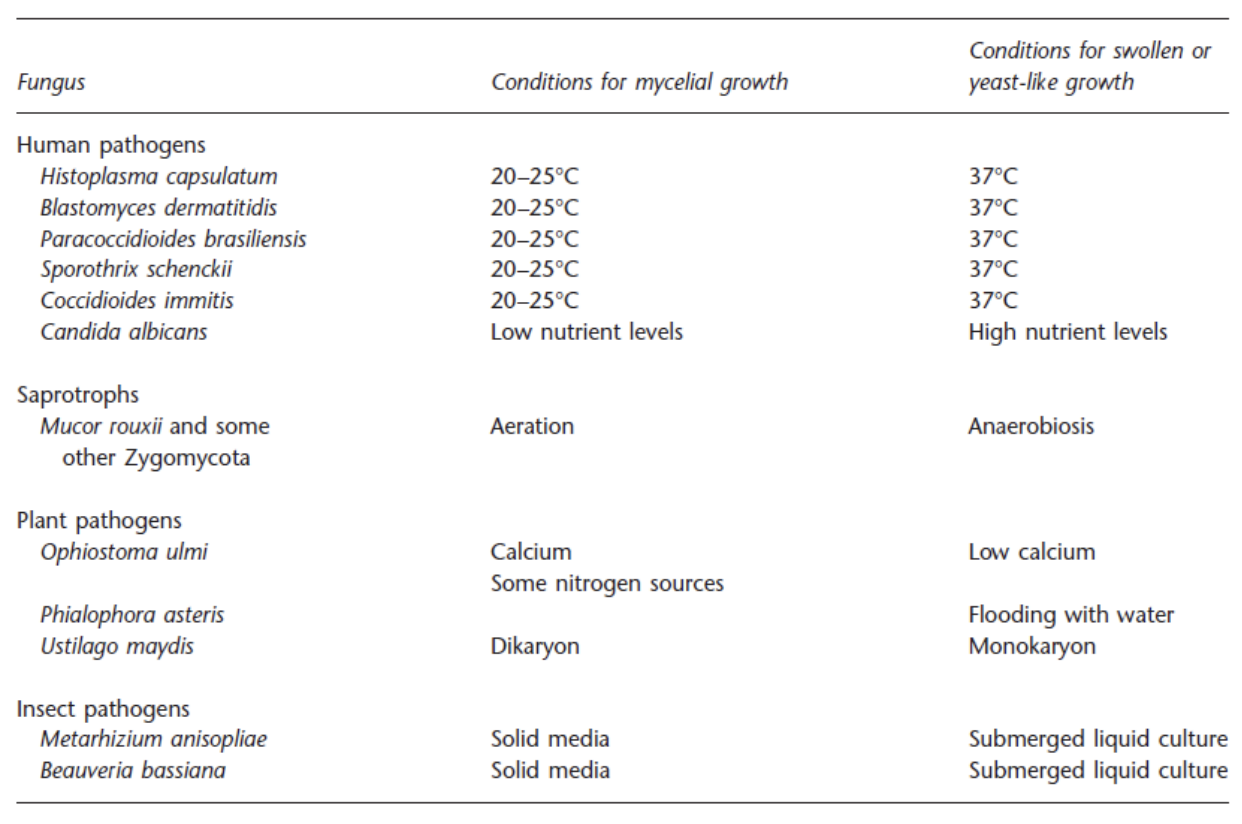
_ is the phase or form fungi usually take in oligotrophic environments where exploration of habitat is needed
M phase (mycelia hyphae, hyphae)
_ is the phase or form fungi usually take in environments with high sugars and dispersal of cells is possible through liquid
Y phase (yeast cells)
T/F: The most diverse differentiation structures actually occur in infectious fungi than non-infectious/pathogenic fungi
TRUE

How are the Y → M and M → Y dimorphic shifts controlled in fungi?
Controlled by signal transduction pathways that alter metabolism, gene expression, and vesicle behaviors mgv
_ are specialized cells or adhesion structures produced by fungi from which a penetration peg emerges that pierces or enters host tissue
Appressorium
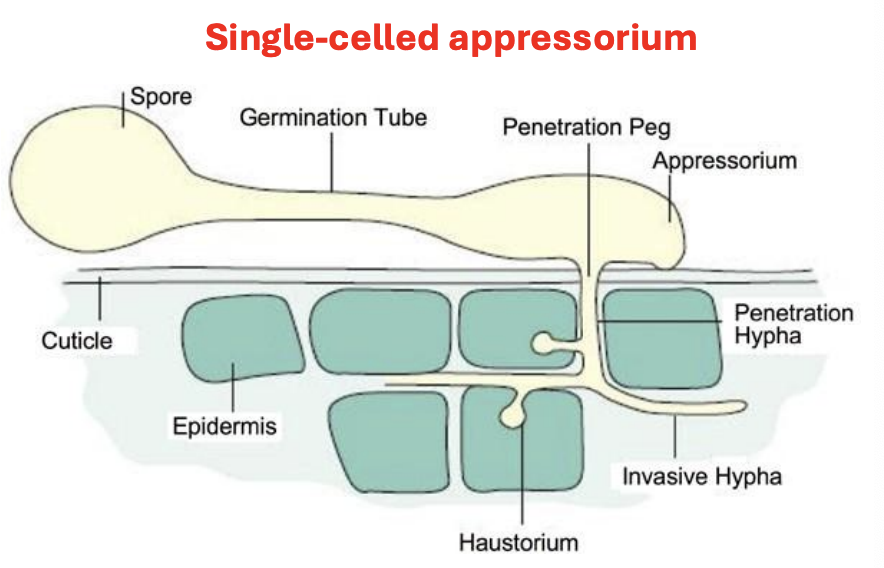
T/F: Mycorrhizal fungi are mutualistic and thus do not form appressoria
FALSE
Even mycorrhizal fungi form appressoria
Explain parts of single-celled appressorium
Appressorium develops from a spore, which forms germination tube and from the GT emerges a
Penetration peg pierces epidermis
From the penetration peg forms a haustorium responsible for nutrient and water acquisition3

Explain classifications of appressoria
Single-celled appressoria
Proto-appressoria
Hyaline/non-pigmented appressoria
Hook-, dome-, lobed, sickled-, nippled
Dark/pigmented appressoria
Dome-, lobed
Compound appressoria
Infection plaque
Infection cushion
Expressoria
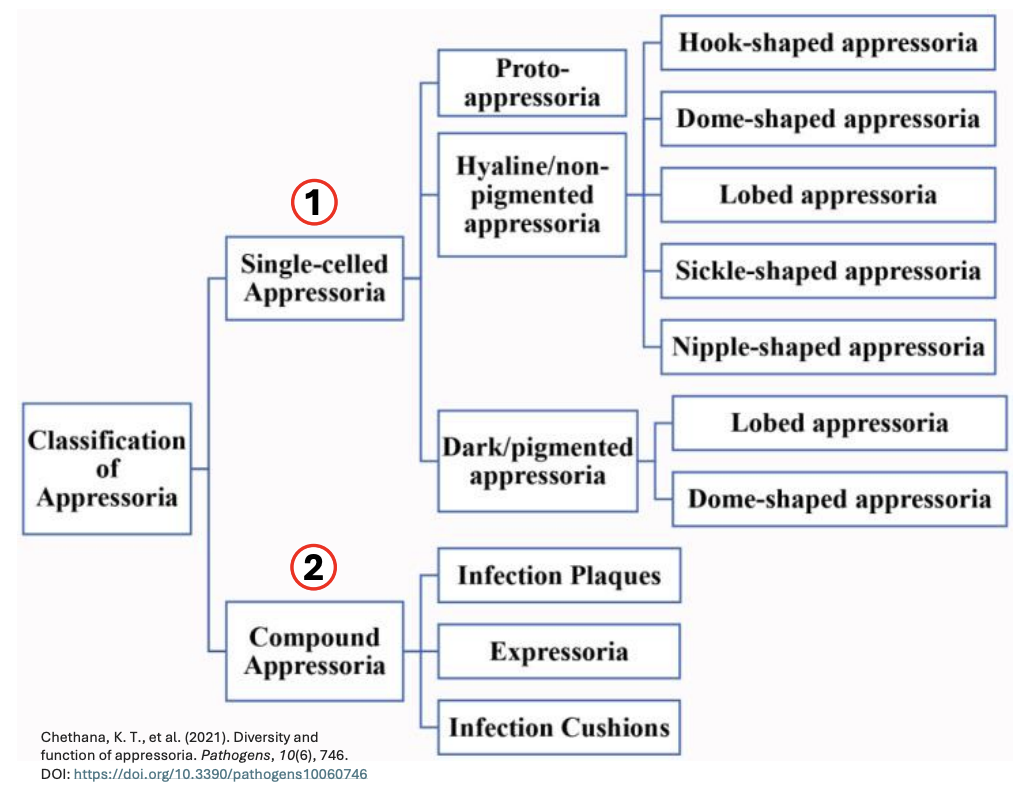
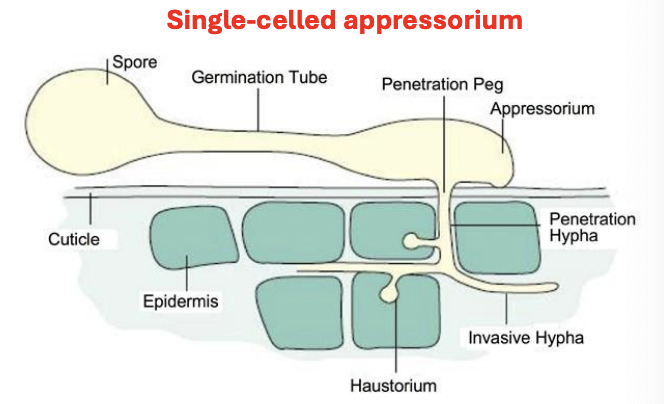
How does a spore form an appressoria?
Once spore lands on a surface, receptors on the spore will try to get a feel of the environment and detect whether the surface corresponds to their host
They’re able to do this because they can sense tactile surface
Thus, depending on hardness/softness of surface, they will decide whether or not this is a possible host they would want to penetrate
It is with the help of the high osmotic pressure in glycerol inside appressorium that draws water into appressorium + turgor pressure generated by the added mechanical strength of the melanin layer
Together, these generate enough pressure to create an outgrowth, which bores a hole into the surface of a plant cell and penetrate cuticle and epidermis
Once PP is inside, hypha secretes effectors, which stimulates plant to provide fungus with nutrients
With enough nutrients, fungus will continue to grow its hyphae and further colonize plant tissues
T/F: Most appressoria are found in plant-infective fungi
TRUE
Human-infective fungi do not need appressorium because fungi usually gets into human body through inhalation/ingestion
Appressorium have structures that allow their penetration of the host cell epidermis, including _
Glycerol (sugar alcohol) has high osmotic pressure that draws water into the appressorium, thus increasing the turgor/hydrostatic pressure to push the penetration peg or hypha into the cuticle and epidermis
Melanin layer serves to enrich chitin cell wall to be able to withstand high turgor pressure generated by glycerol
Invasive hypha mediates the further colonization of plant tissue by the fungus
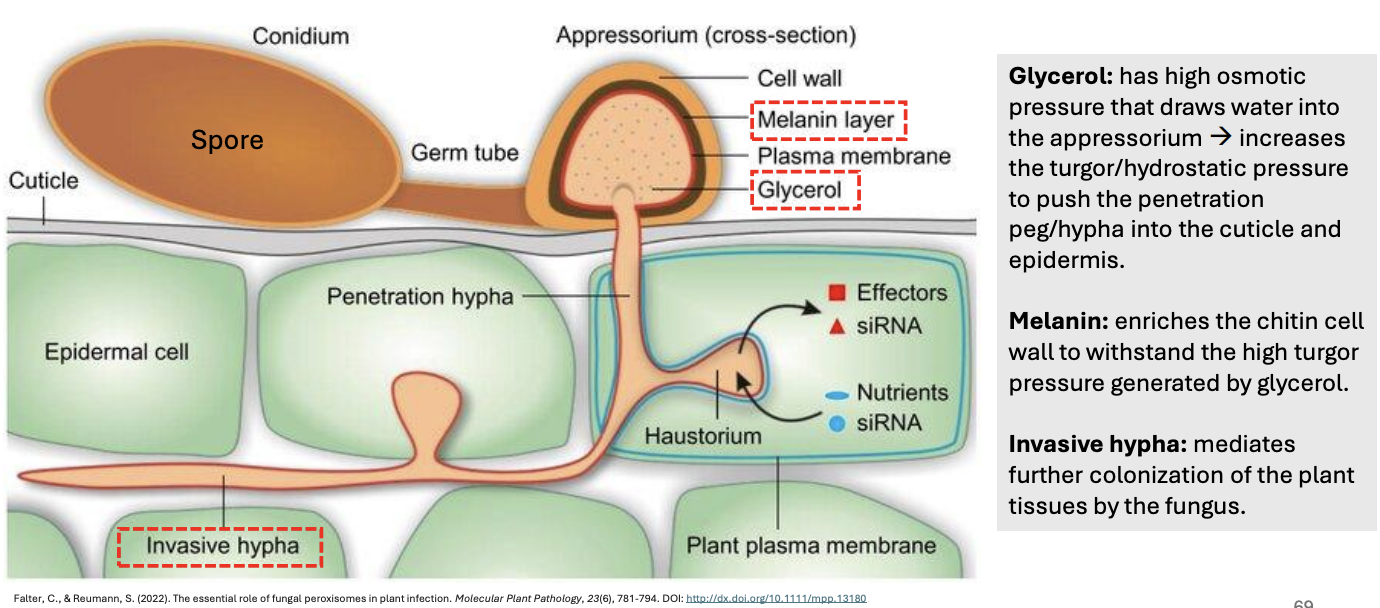
T/F: Without the pressures generated by glycerol and melanin layer in the appressorium, penetration peg will not form
TRUE
Microcycle sporulation vs. (usual) asexual life cycle
Usual asexual life cycle
Spore > Germ tube > Hypha > Mycelium > Spore-bearing structure
Microcycle sporulation
Spore > Short hypha > Spores

Why do stressful conditions drive microcycle sporulation?
Bc through MS, fungus can (1) save nutrients and (1) have mechanism of dispersal into more nutrient-rich environments which are crucial to their survival
Appressoria inside host cells can develop _ to colonize other cells
transappressoria
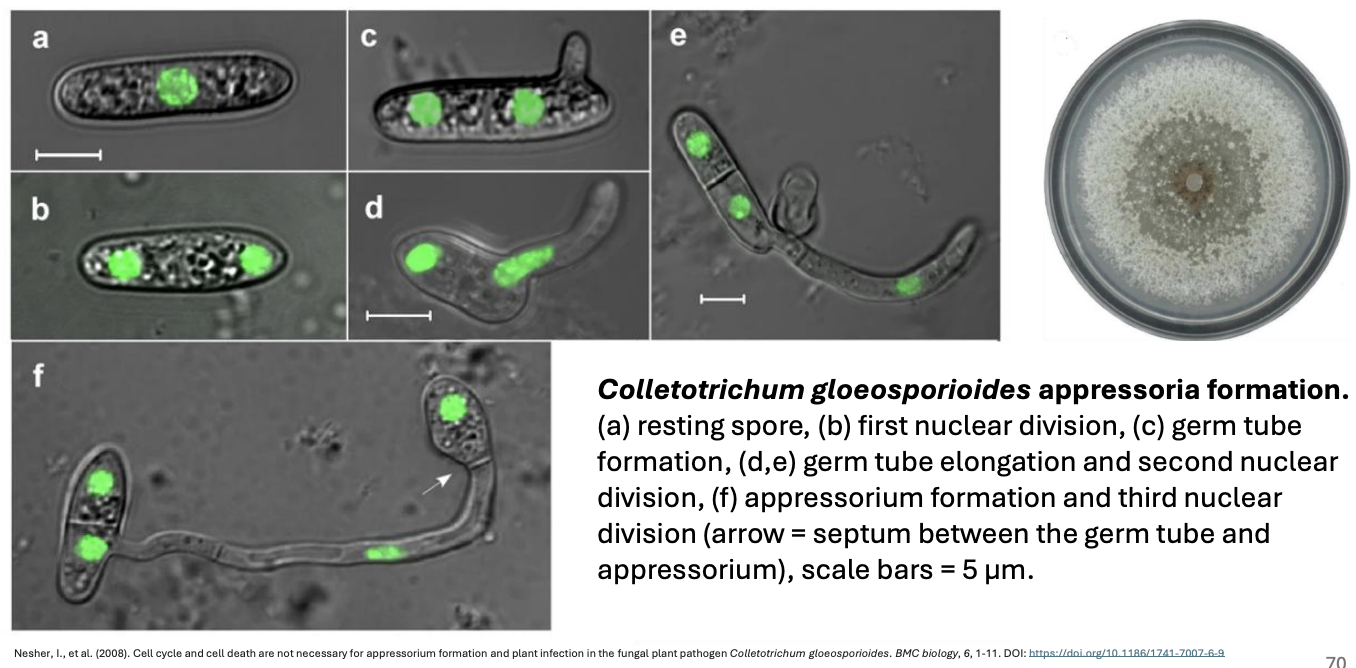
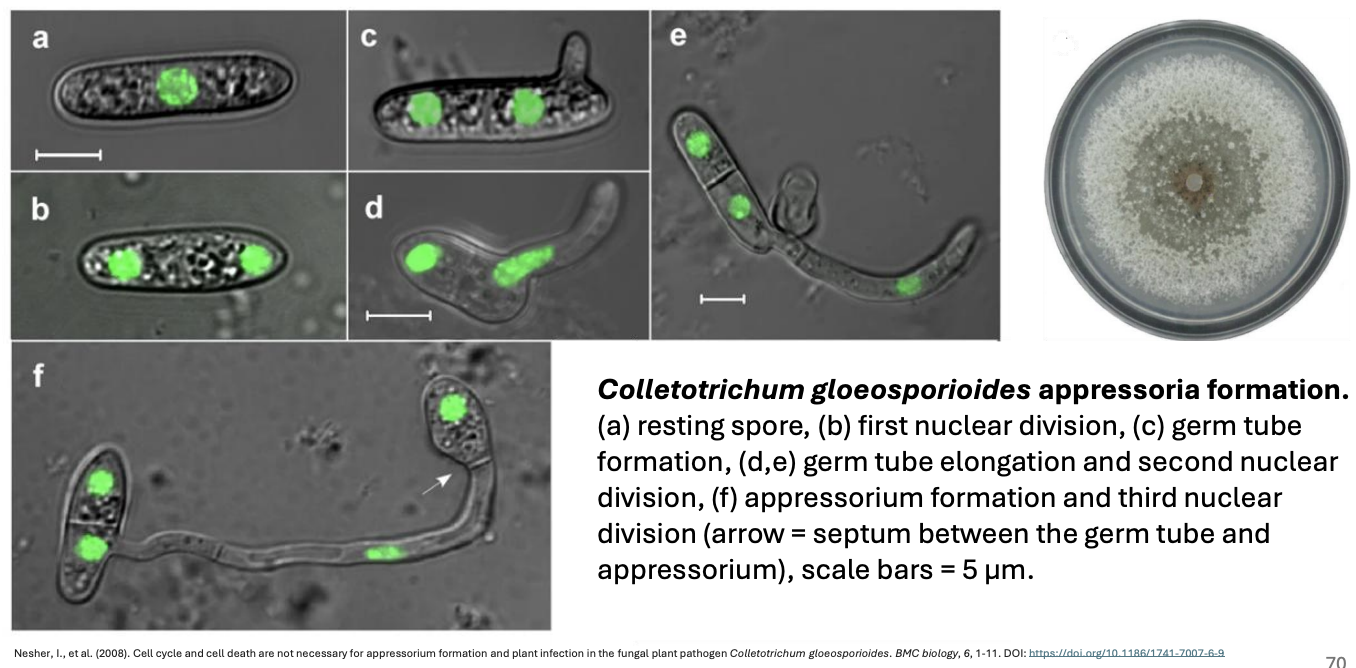
Describe figure shown
Colletotrichum gloeosporioides appressoria formation
(A) Resting spore
(B) 1st nuclear division
(C) Germ tube formation
(D, E) Germ tube elongation, 2nd nuclear division
(F) Appressoria formation, 3rd nuclear division
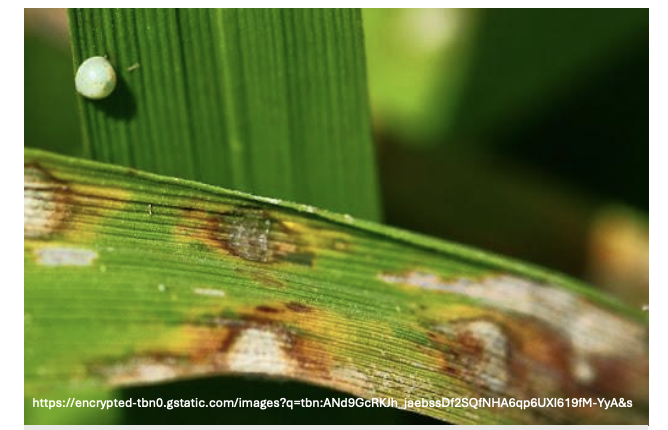
Give example of transappressoria
e.g., Rice blast fungus (Magnaporthe oryzae)
Invasive hyphae become swollen at the rice cell junctions and then undergo several hyphal constriction to pass through pit fields rich in plasmodesmata
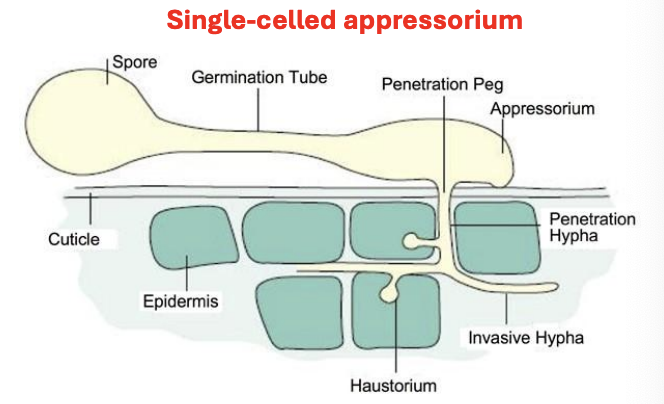
How is appressoria specifically able to penetrate the cuticle and epidermis of plant cells?
It is with the help of the high osmotic pressure in glycerol inside appressorium that draws water into appressorium + turgor pressure generated by the added mechanical strength of the melanin layer
Together, these generate enough pressure to create an outgrowth, which bores a hole into the surface of a plant cell and penetrate cuticle and epidermis
How is transappressoria formed?
Same as appressoria = spore lands on a surface, germ tube, appressorium, penetration peg,
Once penetration peg is inside, hyphae will fill up the plant cell until it comes into contact with plasmodesmata (site of exchange)
At contact with plasmodesmata, invasive hyphae first become swollen then undergo severe hyphal constriction to pass through pit fields rich in plasmodesmata
Then it starts growing again in new cell, cycle repeats until they are able to colonize as much of plant tissues
Give 3 methods through which plants combat fungal infection, e.g., via appressorium
Leaf abscission, basically cutting off the part infected with fungus
Seal off cells with fungi using tyloses
Mobilize immune system
_ are similar to appressorium but develop on short lateral branches of hyphae
Hyphopodium
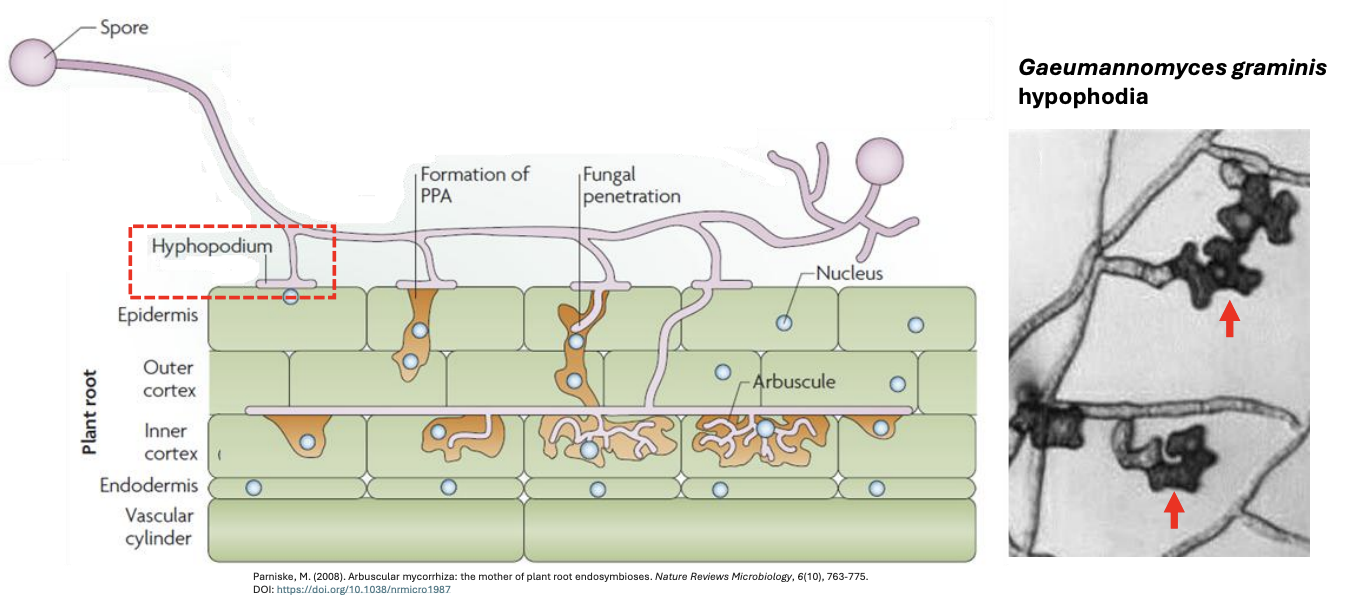
Explain hyphophodium formation (mutualistic relationship)
Plant secretes substances (strigolactones) to recruit spores, while spores recognize secretions and secrete substances (Myc factors), in turn, to ready the plant for penetration
Once hyphopodium is in contact with the plant, it forms PPA (pre-penetration apparatus), which is a portion of cytoplasm of the plant that receives incoming hyphae of the fungus
Only in areas of the plant with PPA can fungus grow
Once inside, fungus then penetrates cells with arbuscules, which are sites of nutrient exchange between fungi and plant
Fungus provides water + inorganic nutrients (phosphorus, nitrogen)
Plants primarily provide carbohydrates (fixed carbon)
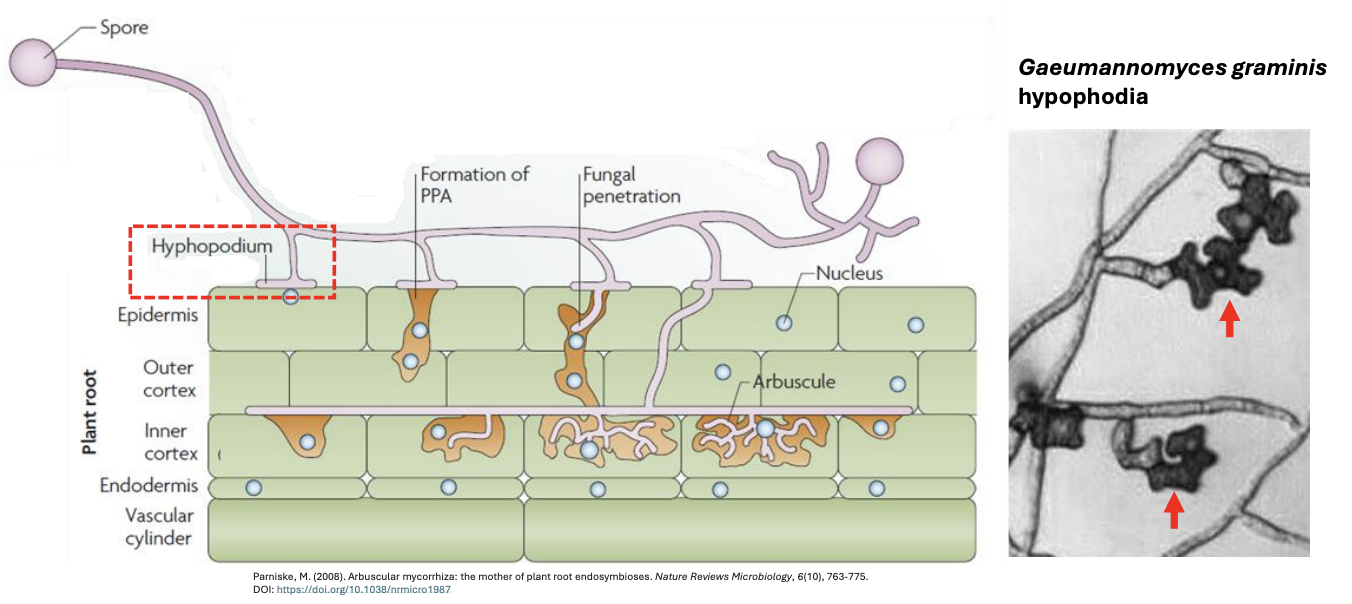
T/F: Arbuscules penetrate the plant’s cytoplasm
FALSE
Arbuscules are limited only to where there is PPA (portion of plant cytoplasm that receives fungal hyphae; modified plant cytoplasm)

T/F: It is possible for a mycorrhizal fungi to become parasitic to a plant
TRUE
Especially if the plant cannot fulfill its role in supplying carbohydrates to fungi
Only in the areas of a plant surface with _ can fungus grow
Pre-penetration apparatus (PPA)
Most important checkpoint is called “start” in G1 in S. cerevisiae because this is where _
cell integrates all information from intracellular and environmental signals to determine whether:
Cell cycle will continue
Cell will enter stationary phase
Cell will undergo sexual reproduction (haplophase)
T/F: In yeast cell cycle, most variation in terms of duration occurs in G1 phase (prep for DNA replication), while S (DNA rep), G2 (prep for mitosis), M (mitosis) together occupy more/less constant time
TRUE

_ allows fungal endophyte penetration from inside out
Expressorium
Explain expressorium formation during stressful conditions
(1-2) An endophytic hypha develops vertically between epidermal cells and produces a swollen expressorium under leaf cuticle
Combined action of meg mechanical force, enzyme activity, and growth repolarization will result in (3-4) cuticle perforation and (5) epiphytic hyphal development

T/F: The only time Epichloe sp. fungal infection is actually confirmed is when it forms expressorium, creating white fuzzy aggregates on leaf surface
TRUE
Epichloe sp. fungal endophyte is typically a quiet inhabitant of a plant, getting some nutrients but, in exchange, provides _
alkaloids that deter insects from the plant
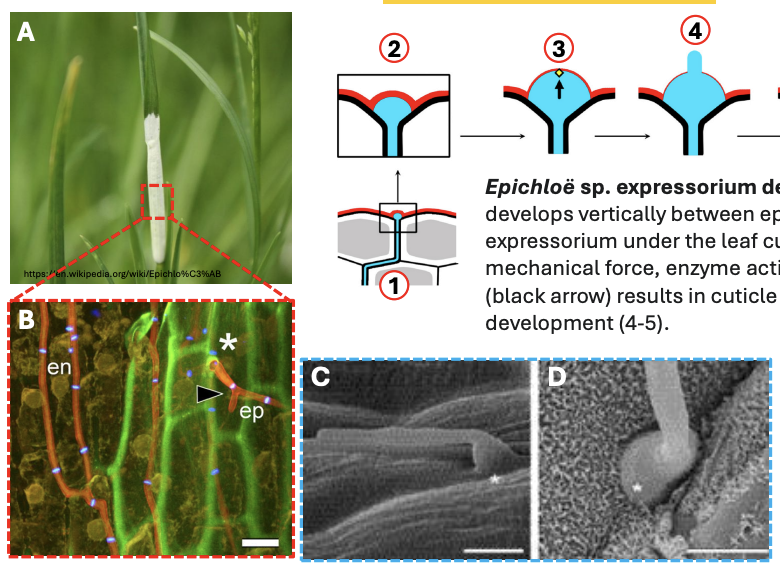
Describe figure shown
(A) Epichloe sp. infecting plant host, evidenced by expressorium formation
(B) Endophytic hypha exiting plant via expressorium
(C) Epiphyllous hypha branching after emergence on leaf surface
(D-E) Expressorium on leaf surface = *
T/F: Expressorium cannot penetrate human skin
FALSE
Fungal infection in human usually involves hyphal growth within the body
_ are multiple appressorial structures dedicated to tissue penetration
Infection cushions
T/F: Infection cushion is the most deadly among all fungal infection structures
TRUE
Bc this is made up of multiple appressorium that clustered together

Describe figure shown
(A) Mature infection cushions of Botrytis cinerea, produced on glass surface, showing developing multiple and successive ramifications of vegetative hyphae
(B) Infection cushions development on leaves infected by B. cinerea
Primary bean leaves were inoculated with conidia and fungal development, 1-4 days post inoculation (dpi)
Fungi were stained with cotton blue, white arrows = infection cushions
T/F: It is possible to prevent the spread and development of infection cushion in a plant via leaf abscission
TRUE
BUT only if spores have not reached the plant’s vascular tissues, otherwise spores may germinate inside plant vessels and infect entire plant
What makes the infection cushion the most deadly of all infection structures?
Composed of multiple appressoria that cluster together
Grows very quickly (~4 days)
Capable of producing and germinating spores, which allows its dispersal and further colonization into plant tissues
Numerous fungal species respond to contact with a surface through _
differentiation
Many fungi are capable of _, where they gain important information about their environment through contact, giving fungi the ability to _
Contact sensing
Differentiate, adapt, direct growth polarity, infect, etc. dagi
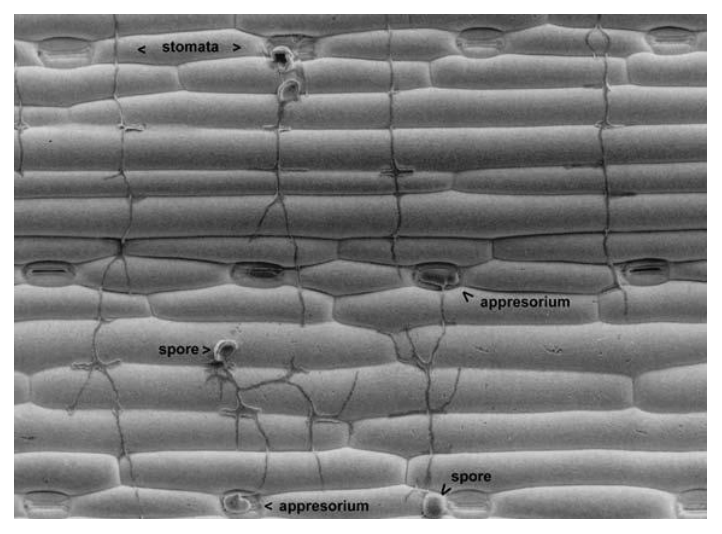
2 types of differentiation (of infection structures via contact sensing)
Describe figure shown
Nontopographical = responding to hard surface
Topographical = responding to ridges and grooves of particular heights and depths or spacing
Growth of Puccinia graminis on wheat leaf replica
Hypha formed always perpendicular to cells, lateral hypha formed on grooves to help stabilize itself as it grows
Appressoria formation is triggered by stomatal pores
Example of combination of nontopographical + topographical differentiation
T/F: Sclerotia are sexual structures that develop via repeated localized hyphal branching
FALSE
Sclerotia are asexual structures that develop via repeated localized hyphal branching
Several morphogenetic factors can trigger the formation of infection structures, but the main requirement is _
contact with surface of sufficient hardness
Hyphopodium is similar to appressorium, only that instead of developing from the germination tube, it develops from _
short lateral branches of hyphae

Mycelial cords are linear aggregates of parallel hyphae that function for _
conduction of nutrients across distances
Infection cushions are multiple appressorial structures dedicated to _
tissue penetration
Several _ can trigger formation of infection structures, but the main requirement is contact with a surface of sufficient hardness
morphogenetic factors
In infection structure development, _ can aid in sensing bumps and ridges
mechanosensitive (MS) ion channels
_ are similar to mycelial cords but have a well-defined structure composed of a growth apex covered with rootcap-like structure made up of hyphae; its main body has uniform thickness and is anatomically split into cortex, medulla, and inner central channel for gas exchange
Rhizomorphs
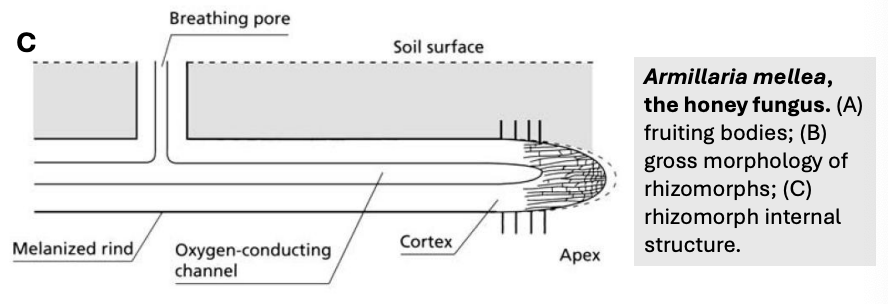

Describe figure shown
(A) Growing germ tube of C. albicans coming into contact with ridge
When growing hyphal tip comes into contact with a ridge, membrane deformation occurs, causing mechanosensitive ion channels to open, allowing influx of materials, e.g., calcium ions, that causes change in orientation of hyphal tip (illustrates how they can change direction in response to a surface)
The other parts of hypha that didn’t come into contact with ridge have their MS channels remain closed
(B) Puccinia graminis growing perpendicularly over ridges and grooves of silicon wafer
Arrowheads point to remains of mucilages that adhered germ tubes to the surface
Hyphae formed projections that grow into the grooves
All evidences to contact sensing ability of fungi
T/F: Hyphopodium formation requires mechanosensing
FALSE
Bc hyphopodium formation is induced by the substances secreted by plants to recruit spores, e.g., strigolactones
5 structures arising from differentiation but do not function for infection
Sclerotia = dormant survival
Mycelial cords = nutrient conduction across distances
(except) Rhizomorphs = invasion & decay, water, nutrient, gas transport, competitive advantages, infection
Sporangium
Conidiophore
_ form compact nutrient-storing structure with discernible layers, namely rind, cortex, and medulla
Sclerotia
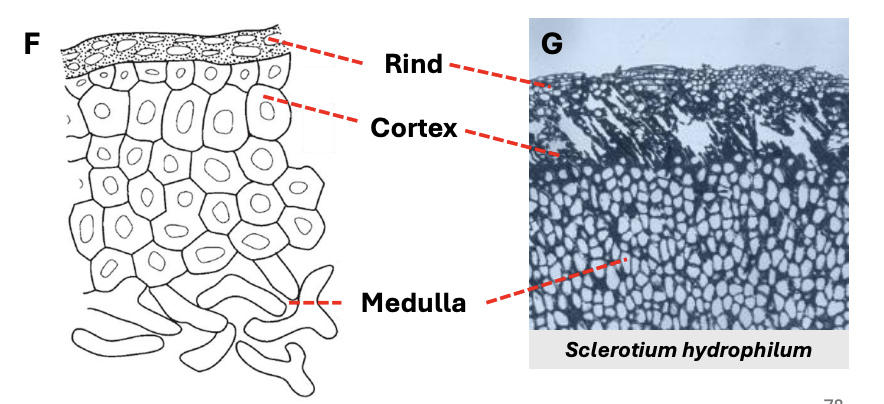
T/F: Sclerotia is a reproductive structure
FALSE
Sclerotia is neither a reproductive nor vegetative structure but a survival structure
T/F: Sclerotia are exclusive in Basidiomycota
FALSE
Microsclerotia (100 um diameter) are found in ascomycetes, e.g., A. niger
_ is a compact mass of hardened mycelia containing food reserves and has a melanized rind capable of surviving harsh conditions and environmental extremes
Sclerotia
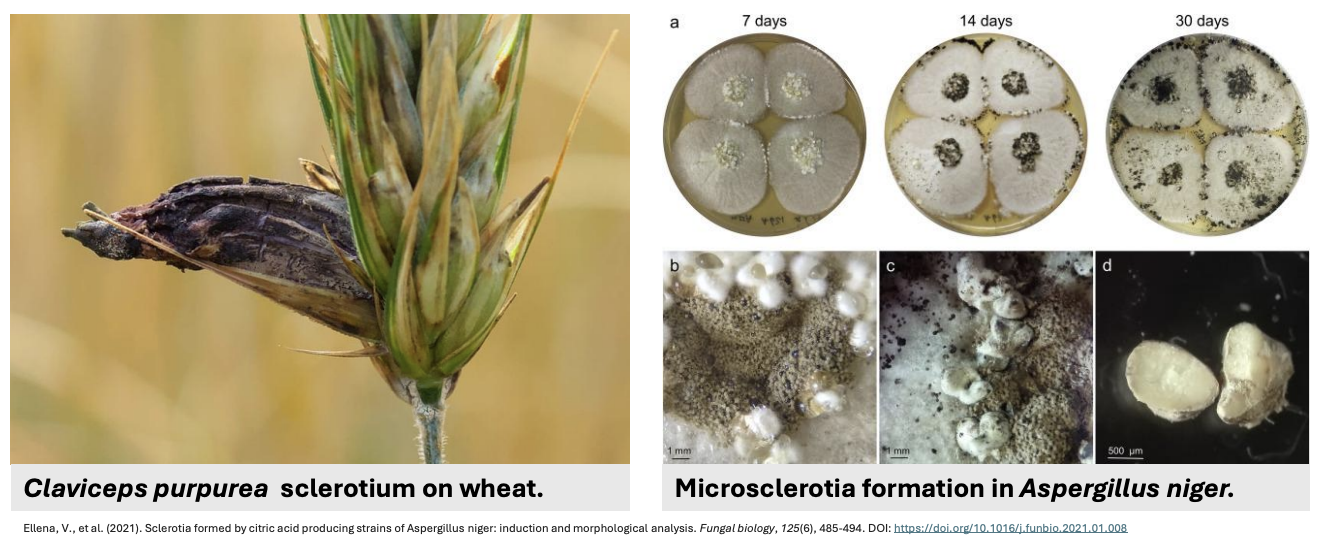
Sclerotia are mostly formed in _, ranging ≤ 1cm diameter, but other fungi can form microsclerotia (100 um diameter)
Basidiomycota
What makes sclerotia a specialized hyphal body involved in dormant survival?
Compact mass of hardened mycelia containing food reserves
Has melanized rind capable of surviving harsh conditions and environmental extremes
Formed mostly in Basidiomycetes, ≤1 cm in diameter, but other fungi can form microsclerotia (100 um diameter)
_ are asexual structures that develop via repeated localized hyphal branching
Sclerotia
Mature sclerotia is characterized by the presence of 3 layers _
From outermost to innermost rcm
Rind = prominent bc it has melanin
Cortex = smaller cells that may also release liquid exudates
Medulla = contains nutritive content, more loosely arranged hyphae

Sclerotia are asexual structures that develop via repeated localized hyphal branching, developing in 3 steps _
idm
Initiation: hyphae aggregation
Development: sizes increases along with liquid exudation
Maturation: melanization (for UV protection) and formation of internal sclerotial structures
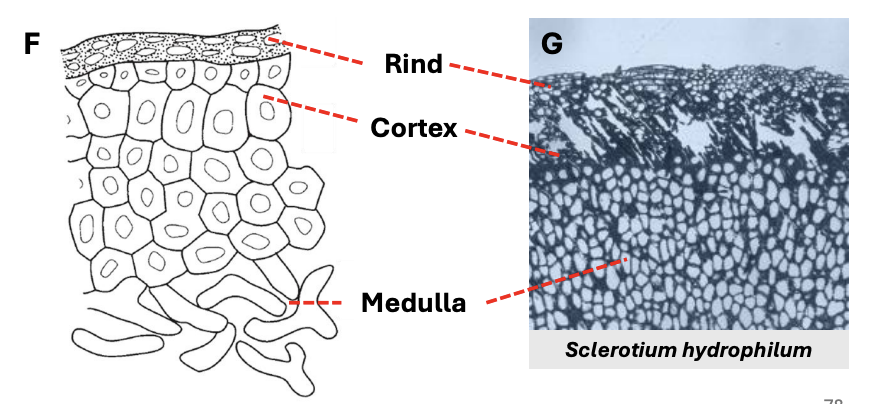
_ is the layer of sclerotia that houses hyphal nutritive content (e.g., polysaccharides, proteins)
Medulla
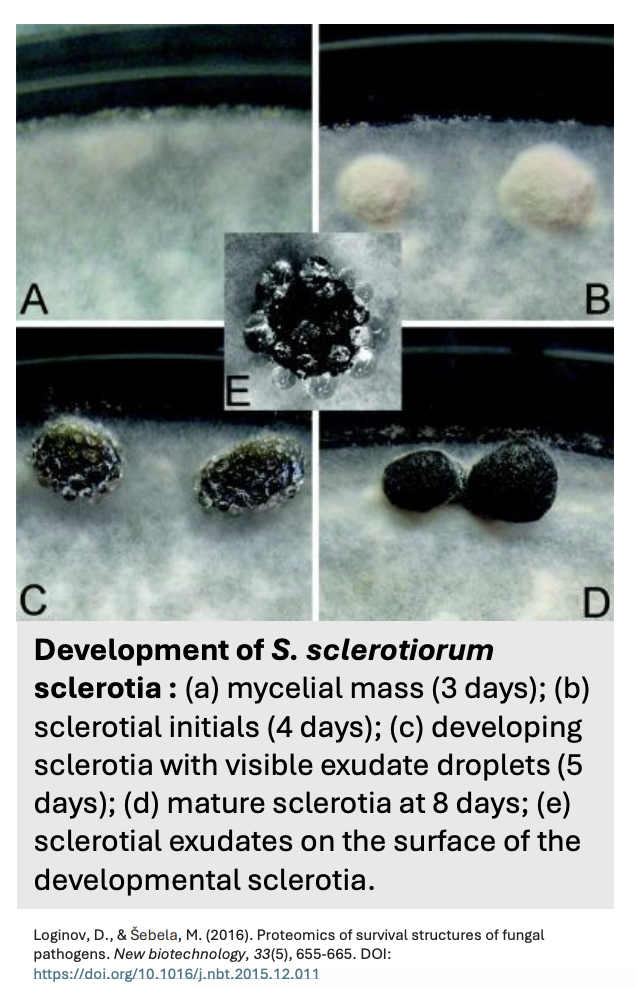
Describe figure shown
Development of S. sclerotina sclerotia
(A) Mycelial mass at 3 days
(B) Sclerotial initials at 4 days
(C) Developing sclerotia with visible exudate droplets
(D) Mature sclerotia at 8 days
(E) Sclerotial exudates on surface of developmental sclerotia